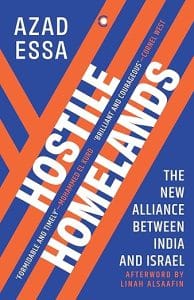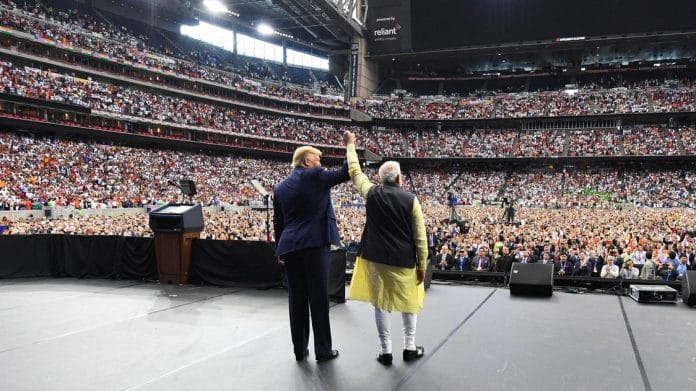In the face of a swelling Hindu nationalist and supremacist movement in India during the 1990s, the same Indian Americans, who had once played a significant role in the agitations abroad against Indira Gandhi during the Emergency years, were now activated to consolidate the Hindu nationalist project. They were now deeply established in the US; their organisations like the HSS, OFBJP and VHPA were now a lot more networked, connected to a community with a lot more wealth, social status and stability. Take Ved Prakash Nanda, for example. A law professor at the University of Denver, Nanda authored papers and articles and testified in June 1976 before a Congressional subcommittee about human rights abuses in India during the Emergency.
He later played a central role in the formation of the HSS in the US, becoming its president in 2002. Or consider Ramesh Bhutada. Originally from Maharashtra, Bhutada moved to the US in 1968. He became politically active following the arrest of his father, a member of the RSS, during the Emergency. Bhutada had organised protests in Houston and formed the HSS branch in the city, later becoming the group’s national vice-president. He also became an energetic organiser for the OFBJP, which helped canvas for Modi’s election in 2014.
Five years later, Bhutada became instrumental in the ‘Howdy Modi’ event in Houston that attracted some 20,000 people, including two dozen US lawmakers and the then president, Donald Trump. And then there is Mukund Mody, who would move from protesting against the Emergency in the 1970s to becoming an integral figure in the formation and organisation of Hindutva groups in the US. ‘In the 1980s, Mody continued to work as secretary-general of FISI and to organise Hindu youth camps in America for the Vishwa Hindu Parishad (VHP).
In 1990, he traveled to India to meet “the hierarchy of the BJP” who wanted to open cells of the party in foreign countries ahead of the 1991 general elections,’ Edward Anderson and Patrick Clibbens write. It was Mody who established the OFBJP in the US in 1991. For his efforts, Mody received a special mention in Narendra Modi’s memoir. In it, Mody is compared with ‘a sixteenth century Hindu general and Rajasthani folk hero who donated his wealth to Maharaja Pratap in order to raise an army against the Mughals’.
In the 1990s, Hindu nationalists in the US prioritised shifting their identity from an ‘Indian’ to a ‘Hindu’ orientation. Moreover, they looked to mobilise their activities around a ‘Hindu Indian state-building project’. In time, the emphasis on ecumenicalism and nationalism, Prema Kurien writes, became the central planks for ‘official American Hinduism’. In so doing, Indian Americans looked to Zionist organisations to maximise their impact on Capitol Hill as well as to become gatekeepers of the Hindus in the US32 and defenders of anything they deemed to be offensive to Hindus. For instance, in 1997, the VHPA formed the American Hindus Against Defamation (AHAD), modelled on the ADL.
Just as the ADL said its aim was to ‘stop the defamation of the Jewish people and to secure justice and fair treatment to all’, AHAD described itself as ‘dedicated to preserving the sanctity of Hindu symbols, icons, culture and customs’. There were other political initiatives. In 1993, Gopal Raju, an Indian American entrepreneur and founder of India Abroad, formed the Indian American Centre for Political Action (IACPA). The IACPA was created to mould a new generation of politically astute Indian Americans.
Raju arranged internships on Capitol Hill and hired Ralph Nunberger, a professor in international relations and a legislative liaison for AIPAC, to help him succeed. In concert with Raju’s effort, US congressman Frank Pallone (New Jersey) and Bill McCollum (Florida) formed the India Caucus, an interest group that recognised India as a US partner and looked to charter strengthening relations between the two countries. The other US congressman who played an integral role was the Democratic lawmaker Gary Ackerman, who advocated a greater partnership between India, Israel and the US. In the late 1990s, Ackerman was co-chairman of the Congressional Caucus on India and a member of the House Foreign Affairs Committee. As the representative of New York’s 5th district, known for being home to a high concentration of Jewish residents, Ackerman was both influential and at the very intersection of US foreign policy towards the Middle East and South Asia.
At a fundraising dinner organised by two Indian Americans in his honour in Atlanta in 1999, Ackerman described ‘strong India-Israel relations’ as ‘very critical to ensuring peace and stability in a part of the world that is characterised by instability, fundamentalist religious bigotry, hatred toward the West and its values and murder and mayhem spawned by acts of cross-border terrorism’.
He, too, described India and Israel as ‘ancient civilisations [that] have much in common politically and economically, and share strong democratic beliefs, traditions and values’. Ackerman also said, ‘As many of you are aware, Israel, just like India, is a special place for me […] and as such, you all should consider me as your bhai—your brother.’ Within ten years, the India Caucus went from eight members to a quarter of the US Congress. ‘It helped, of course, that the Indian American community had money in its pocket and its “leaders” (those with money) wanted to be players in D.C,’ Vijay Prashad writes.
For their efforts, both Ackerman and Pallone were awarded major civilian awards by the BJP government in 2002. During its years in power between 1998 to 2002, the BJP routinely urged the Indian diaspora to invest back home as well as to represent its interests abroad. On cue, the Indian diaspora began sending charity to Hindu nationalist projects, and investing heavily in the IT, software and start-up efforts in India.
It simultaneously continued to underwrite efforts to lobby for a narrow pro-Hindu, pro-business agenda in DC. While remittances in 1990–91 were estimated at $2.1 billion or 0.7 per cent of India’s GDP, they rose to $12.3 billion by 1996-97. By 2006, they had become 3.1 per cent of the country’s GDP, contributing even more than India’s software exports.39 To put these figures into perspective, India had begun to receive more remittances from the diaspora than it spent on its healthcare or education.
Moreover, the strength of the dollar and the liberalisation of the economy allowed Indian Americans to take a particular interest in real estate, too.
So much so, it was estimated that by 2005, 20 per cent of all properties over $250,000/Rs 10 million in India were purchased by Indians abroad. Studies showed that while in 1990–91, remittances from North America amounted to 24 per cent, money sent from the Gulf was around 40 per cent. By 2006, the scenario had flipped: only 24 per cent of remittances were sourced from Indian migrant workers in the Gulf, while remittances from North America had increased to 44 per cent. The consolidation of the Indian community in America precipitated a growth in temples, Hindu associations and visits by religious figures and musicians. Naturally, the economic power wielded by the Indian American community meant that India also began catering to its needs.
Even mainstream blockbuster Bollywood films began examining themes like ‘nostalgia’, ‘longing’ and ‘nationalism’ as experienced by the diaspora. To be an authentic ‘Indian’ was to be unequivocally devoted to the values of a certain, purportedly unobtrusive, Hinduness. Raj (played by Shah Rukh Khan) in Dilwale Dulhania Le Jayenge (1995) refuses to elope with Simran (played by Kajol) without the approval of her father.
The film makes it clear that it is his Hindu Indian values, dipped in South Asian patriarchy, that prevents him from doing so. In the movie Pardes (1998), Arjun (Shah Rukh Khan), as a ‘good’ Indian-born man, is pitted against his stepbrother, Rajiv (Apurva Agnihotri), a foreign-born Indian man who indulges in every vice imaginable. While Arjun is humble, cultured and respectful, Rajiv is philandering, crass and a borderline alcoholic. Arjun is East, Rajiv is West. No surprise that Arjun wins the girl Ganga (aptly named to represent the Ganges, the holiest river in Hinduism; Ganga is played by Mahima Chaudhry). American capitalism was completely acceptable, if you retained Hindu Indian traditions, the film’s subtitle ‘American Dreams, Indian Soul’ seemed to suggest.
There were several other films which either packaged ‘longing’ for the homeland, like Swades (2004), about an Indian engineer at NASA, who answers a yearning to return to his village in India, or like Kabhi Khushi Kabhie Gham also known as K3G (2001), in which Indian families were depicted as thriving upper-caste industrialists living in palaces abroad. In K3G, the main protagonist, Rahul (played by Shah Rukh Khan), falls in love with Anjali (played by Kajol), a woman of a ‘lower social standing’, sparking a feud in the family. The dispute is most certainly over her belonging to a lower caste, but the film doesn’t say so, allowing the audiences in the diaspora, where the film broke multiple records, to leave the matter unnamed in their real lives, too.
For many Indian Americans, particularly Hindus, caste was a burden of the past in a backwater village in rural India, or an idea invented by the British; it didn’t exist in America. But in many ways, caste oppression has manifested itself in more complex ways in the US. Upper-caste Hindus dominate the Indian American community and, therefore, Hinduism in America is created in their image. Their attempt to shape ‘India as Hindu’ as well as the common tendency to treat Indians in the US as a monolith has meant the silencing of Indian Muslims, Dalits, tribals and Christians. Their struggles as subjects of Hindutva and Brahminical oppression are erased, too.
Indian Americans who fit snugly into the ‘upwardly mobile model minority’ caricature looked to imbibe the myth of America as the land of opportunity. While they were open to accepting that structural racism existed in the US (given they were victims of racism, too), as highly educated Indian Americans pursuing the American dream, they differentiated themselves from African Americans, whom in time they saw as economic and social burdens on the system, much like the lower caste and urban poor back in India. In other words, a segment of the Hindu Indian American community began seeing their success as a symbol of their culture and individual hard work, as opposed to a direct result of their place in a racial hierarchy or in the caste hierarchy that had given them the opportunity to study and the social mobility to leapfrog over other communities in the US.
As ‘Jews had become white folks’ in the 1960s, Vijay Prashad argues that ‘Hindus became Jews’ in the latter half of the century. They imbibed the very privilege of the white and increasingly corporate America. By the late 1990s and early 2000s, these Indian Americans who had made it in the US were helping shape the social, economic and political landscape back home. They were self-styled ‘pioneers’.
 This excerpt from Azad Essa’s ‘Hostile Homelands’ has been published with permission from Context, an imprint of Westland Books.
This excerpt from Azad Essa’s ‘Hostile Homelands’ has been published with permission from Context, an imprint of Westland Books.







Oh God! What am I reading on The Print nowadays?
Has the editor completely lost his/her mind?
All along, we have been told that Hindutva was inspired by Nazism and Fascism. The Sangh gets vilified because Moonje met with Mussolini and was allegedly impressed by his thoughts and ideas.
Now, all of a sudden, Hindutva is being linked with Zionism.
And The Print is happily providing a platform for such disinformation campaigns against upper caste Hindus. What a shame!
You are getting a “journalist of Pakistani origin to write shit. Shekhar Gupta has finally gone bonkers